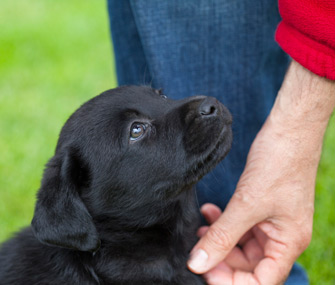Can I Teach My Puppy to Tolerate Petting?
Published on November 05, 2012

Q. My puppy gets squirmy when I try to play with her ears or feet, and struggles to get free. Can I help her get comfortable with petting? I’m worried this aversion will cause a problem when she’s an adult.
A. You’re right to anticipate that your puppy’s discomfort may be an issue later on — problems can arise with dogs who aren't taught to relax while being handled. Puppyhood is the best time to teach your dog that it's OK to be touched, lifted, cuddled and moved. This is important during veterinary exams, grooming and nail trims. Teaching your puppy to tolerate touching will also make her less likely to react if an accident occurs, such as someone tripping and falling over her.
Many dogs have specific areas where they are uncomfortable being touched, like the paws and ears. Your goal is to get your puppy comfortable with being held, touched and moved in a variety of ways, while paying special attention to her more sensitive areas. Rather than forcing your puppy to stay still while you’re handling her, which doesn’t eliminate the fear or discomfort that causes her panicked reaction, teach her that good things happen when you’re touching her. You want to take an uncomfortable experience and turn it into something that she not only tolerates but enjoys.
Help Your Puppy Relax
Choose a time when your dog is relaxed and comfortable, such as when she's settling down on the couch at night. Right before you pet her, give your dog a cue, such as “cuddle,” to let her know what you’re going to do. Begin by petting areas where your dog already tolerates touching, to help her stay relaxed. If your dog is uncomfortable with her paws being handled, for example, start petting away from the paws and in an area she's comfortable being touched, such as her shoulder. Say your word, “cuddle,” and then touch this area. Immediately after, give her a palatable reward, such as a small slice of cooked turkey hot dog.
Once she is excited about her reward and is staying relaxed when you say your cue and touch her, you can move your hand a bit closer to her paw. Move in small increments that are barely noticeable to your dog and only continue as long as she stays relaxed. If she starts to show signs of stress, such as yawning or tensing her muscles, or if she tries to get away, move your hand back to an area where she is comfortable being touched. Keep in mind that it will take some time for your puppy to get used to being touched on her paws and ears, and be patient.
Over several sessions, your puppy should begin to relax enough to let you get closer to touching her paws. Once you’ve reached the paw area, say your cue, touch her paw briefly and immediately reward her. If your puppy stays relaxed, work up to handling her paws for longer periods of time and touching them in different ways, such as feeling between the paw pads or touching the nails.
Repeat the same process for ear handling: Say the cue “cuddle” and then touch your puppy on her neck. If she stays relaxed, slowly move closer to the ear. Once she is comfortable with having you touch her ear, add different types of touch, from briefly touching the ear, to holding it for longer periods, to actually being able to move the ear around and look inside. As you progress to more detailed touching, delay her reward — in other words, make your puppy wait until you have looked inside her ear before you treat her.
Frequent treats can gradually be replaced by other rewards, such as a play session after being handled. You can also offer one highly palatable treat after a longer period of handling, such as a dental chew after examining her ears, rather than a series of smaller treats. If your dog continues to be uncomfortable with being touched, even with training, or if she shows aggression at any time during the training, immediately contact your veterinarian for further advice or a possible referral to a qualified animal behaviorist.





